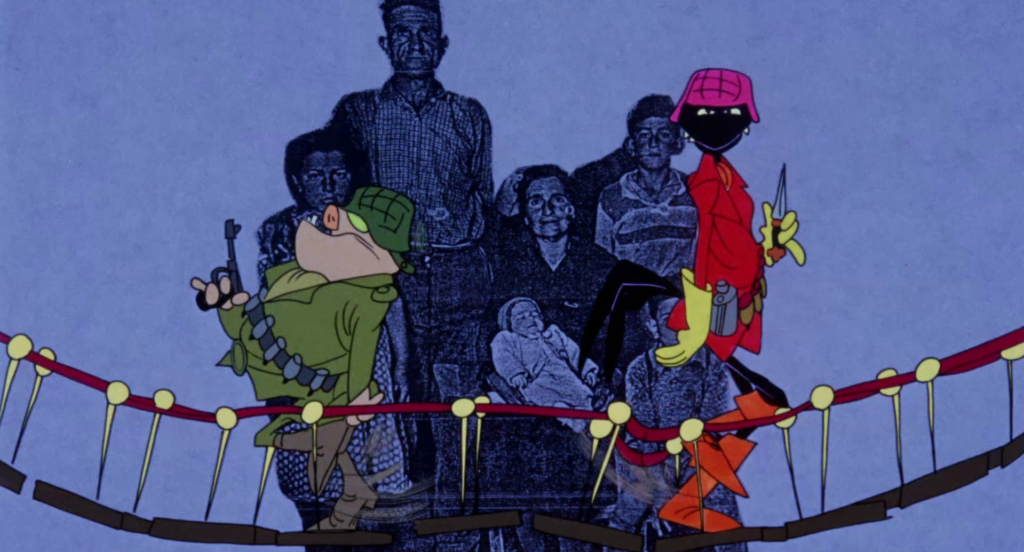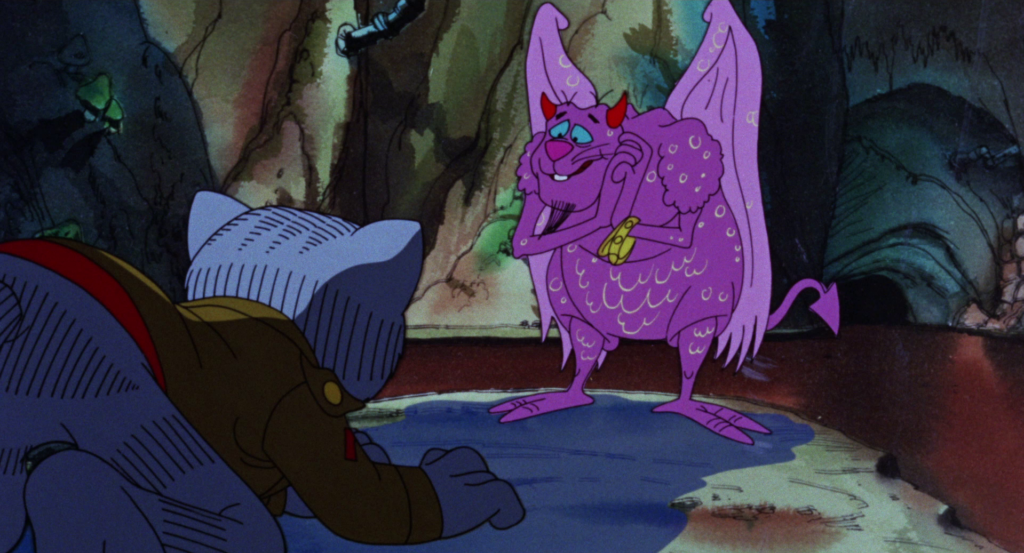Fritz Follow-Up Flatlines
DIRECTED BY: ROBERT TAYLOR/1974
BLU-RAY STREET DATE: OCTOBER 26, 2021/SCORPION RELEASING VIA KL STUDIO CLASSICS
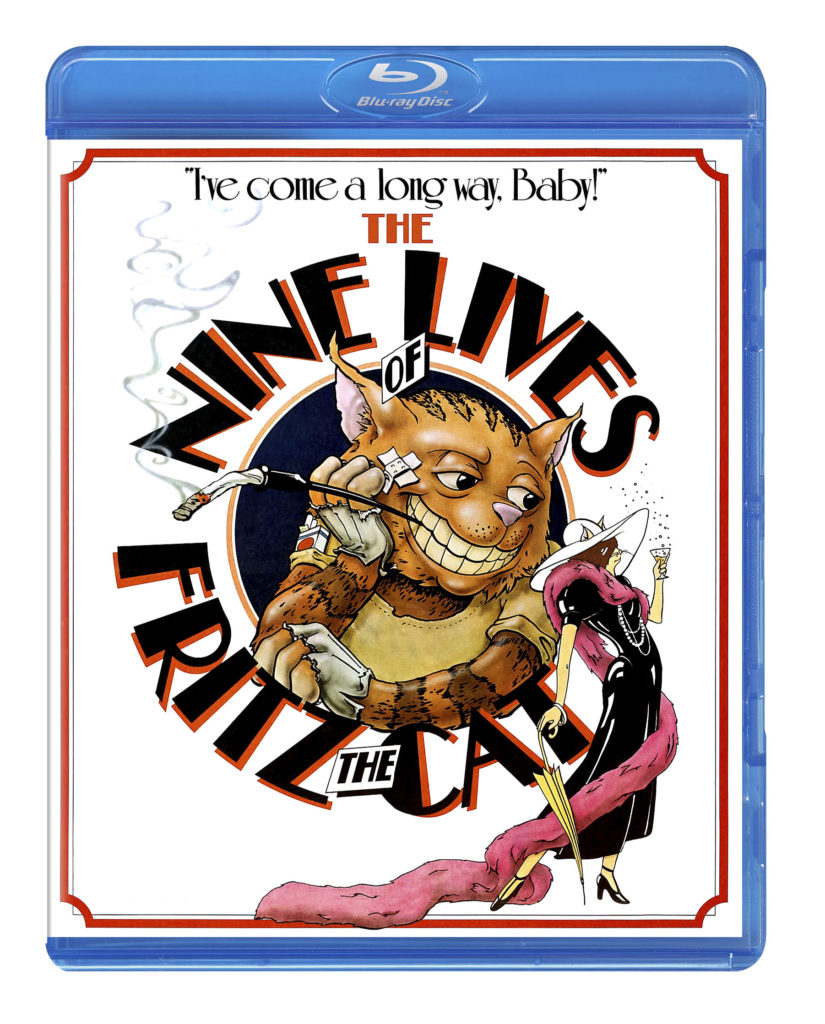
In 1972, Ralph Bakshi’s Fritz the Cat revolutionized mainstream American animation. The thoughtful, bawdy, crude, and – most pertinent to the producers – highly profitable venture into the realm of the adult feature cartoon proved that animation with explicit content and more mature themes was viable, kickstarting Bakshi’s career and paving the way for future works.
Despite that significance and its overall strength, Bakshi’s feature debut also suffers from a host of issues, big and small. One of the most significant of these is its tacked on epilogue, as the revelation that Fritz survives the bombing of an oil refinery results in a frustratingly out of place, mindless ending. However, the dire consequences of Fritz’s survival wouldn’t be fully realized until two year after the film’s release.
1974’s The Nine Lives of Fritz the Cat makes its Blu-Ray debut courtesy of Scorpion Releasing and Kino-Lorber Studio Classics, releasing simultaneously with the much better original. Director of the first Fritz, Ralph Bakshi, does not return, burnt by dealings with producer Steven Krantz and with far better films to make. Instead, animator Robert Taylor was handed director’s duties for this hurried cash grab, an otherwise capable artist who was woefully ill-equipped to handle an adult animated feature. An incompetently constructed, lethargic mess of an anthology story following the various lives of the eponymous feline, Nine Lives can’t even bother to be bad in a particularly interesting way. A time waster that seems to drag on for an eternity despite being shorter than the first film, the viewer’s malaise only giving way to the burning sensation of rising bile at the myriad instances of explicit racism, sexism, and homophobia. On a stylistic level it liberally borrows from Bakshi’s original, but it’s completely lacking in an artful use of these elements in ways that complement the scene, let alone the film as a whole.
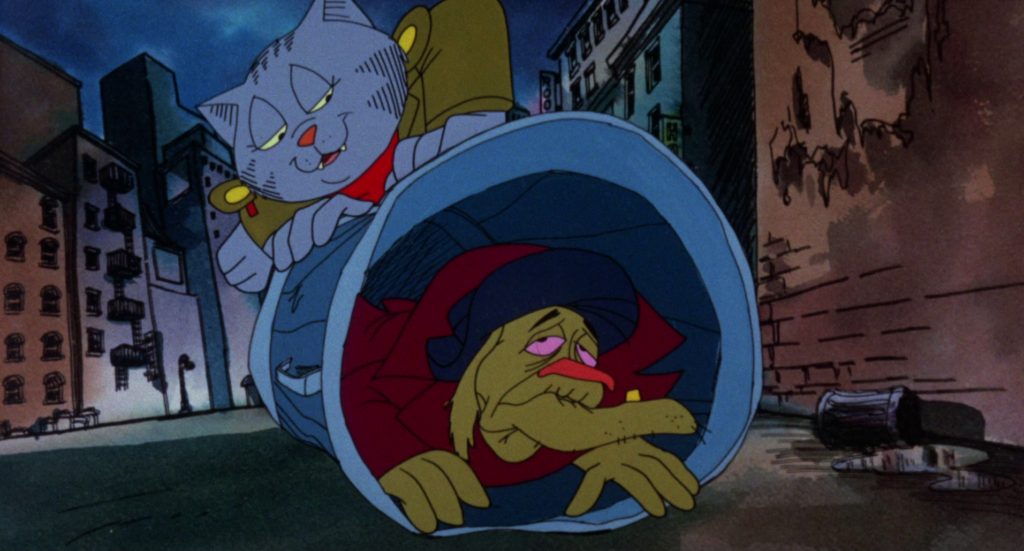
The Nine Lives of Fritz the Cat opens with an imitation of the original’s 1960s title card, this time announcing the film is in the 70s, setting the stage for a series of blatantly recycled ideas from the first film that possess none of the larger narrative or thematic meaning. Fritz sits in a rundown apartment, yelled at by his wife as he lights up a joint to help tune out the noise, Fritz drifts into memories, experiencing an out of body experience of himself walking around town, interacting with a variety of figures and leading into him telling stories of past and even future lives. In one life he has sex with a Puerto Rican cat and is summarily shot by her husband. In another, he’s a Nazi soldier serving under Hitler, featuring an extended, painfully unfunny psychotherapy sequence highlighting Hitler only having one testicle and being homosexual, concluding in him raping Fritz. An interminably long sequence supposedly about Fritz in the 30s, but mostly serving as an excuse to recycle stock footage from old films and recycled animation of lights. Fritz as an astronaut, having sex with a reporter, and his spaceship exploding into another lengthy, meaningless segment of animation as various nonsense objects appear from the explosion. Perhaps the worst of all, a hideously racist story of a future life, where Fritz is sent to the apartheid “New Africa” by president Kissinger.
In the interim, the less imaginative vignettes are mostly just Fritz moseying from place to place, wasting time – the viewers, for the most part – or encountering a sufficiently offensive caricature to annoy the audience rather than just bore them. Encounters with sewer-dwelling “Indian gurus”, an infuriating meeting with a phantom Duke – a major crow character from the first from the first film – featuring lazily recycled animation and a worse vocal performance, a Jewish pawn shop owner used for some truly baffling toilet humor, and finally a confrontation with the devil himself, depicted as gay and describe using slurs. Of course. After that, the opening story of Fritz being yelled at by his wife is wrapped up, with Fritz kicked out of his home, declaring that “this life is the worst I’ve ever had!” and dancing into the night.
The narrative of Nine Lives of Fritz the Cat is bad. Even when employing a more direct anthology style, as opposed to the loosely assembled vignettes of the first film, nothing here hangs together, no scene flows naturally into the next. Every sequence is stretched far beyond its capacity, dragging on forever with painfully unfunny banter, inane rambling with no substance to it at all. The 30s life and the conclusion to the astronaut life are particularly egregious time wasters that kill whatever tiny amount of momentum the film might have, though that’s really not saying much. And when it isn’t boring, Nine Lives is contemptible.
The depiction of women and gay characters is frustrating, to say the least. Fritz’s wife is a nag, all the crow women are hyper-sexualized to a worse degree than even Bakshi’s lackluster presentation of his female cast, and gone are even edge cases like Winston or the more sympathetic but troubled Harriet. Gay characters didn’t crop up much in the first film, but Bakshi’s depictions were typically at least more sympathetic if not highly compromised. Here, the most prominent gay characters are Adolf Hitler and Satan. The only thing that keeps these depictions from seeming as odious as they should be is that they’re made without a shred of conviction, like so much of the rest of the film it’s a sort of vapid cruelty, a bigoted joke told half-heartedly by someone so apathetic it’s more likely to elicit annoyance and mild disgust rather than outrage.
Far more worthy of outrage is Nine Lives treatment of black characters. Certainly, it leads with the usual suspects, a pair of black thieves in the opening, the highly sexualized crow reporter in the astronaut segment, bad but nothing outside the typical range for the film. Then, there’s the “New Africa” segment. Inexplicably the section with the most effort put into it both technically and narratively, it imagines a future where America has been divided, with the black population forming New Africa. Fritz is sent to the nation to deliver a message to the President at the “Black House”. Much of what he encounters is clearly imitating what Bakshi was attempting with the Harlem segment in the original Fritz, but instead depicts a rundown cityscape laden with violence and drug trafficking that is the direct result of a government controlled by black people.
It so utterly misses the point, and heightens both the sexualization and violence perpetrated by the black characters against one another in such a way as to depict them as the root cause of their issues, indirectly blaming black militant groups for poor living conditions. It so utterly misunderstands and mischaracterizes what Bakshi had presented in his film, shamelessly cribbing from him while simultaneously refuting the nuanced political message in his work, in such a way that feels knowing. Nine Lives of Fritz the Cat is a miserable experience, but this segment in particular is deeply contemptible, one of the few times the film is able to engage the audience if only to elicit a more pointed indignation rather than the simmering loathing and boredom it primarily conjures.
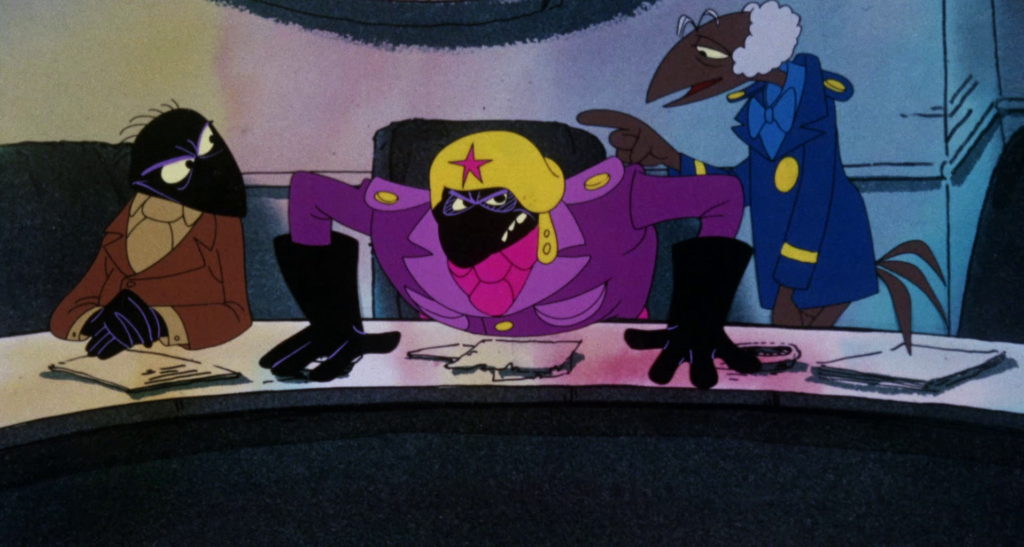
The actual presentation of Nine Lives isn’t appalling, with animation even tending to be a bit more on-model than in the first film, but most of its more interesting visual cues are just watered down versions of something from Bakshi’s film. What it does bring to the table for more original elements is largely just bad, the stand out being the protracted, boring 30s sequence. The soundscape too is lesser down, lots of standard stock effects poorly used at worst, forgettable at best. The soundtrack is a few okay licensed tracks that aren’t implemented terribly well and a score that doesn’t stick with the viewer in the slightest.
Animation in Nine Lives is bad at most times, barring a small handful of acceptably done scenes. A pervasive issue is in the timing, with lots of stiff, robotic animation plagued by even spacing between drawings and little follow-through. None of the more naturalistic animation employed in segments of the first Fritz is employed, which especially harms the animation set to interview with subjects. There is nothing to ground the viewer in the way the first film could, nothing close to something like Fritz’s rant, or Duke’s death, or any number of far better, more stylish sequences from the first film.
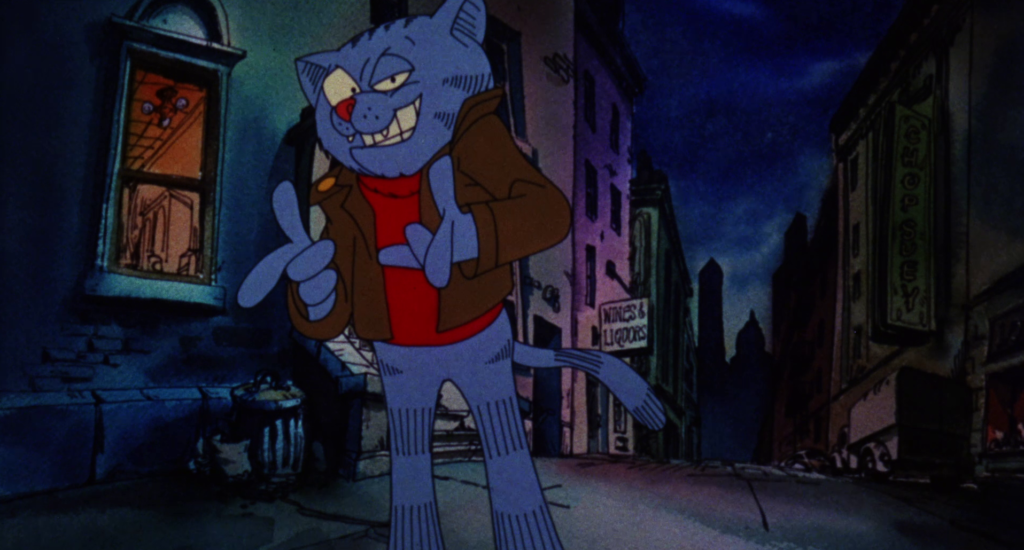
The Blu-Ray release is fairly ho-hum, though I can hardly blame Scorpion or KL Studio Classics. It has a few trailers for other Scorpion releases and the trailer for Nine Lives and that’s your lot. Restoration quality is solid, well done as always, but the added clarity does little to make the film any more enjoyable. While nothing outstanding, I would still say it is a far nicer release than the film deserves.
If I have not made my thoughts exceedingly clear, Nine Lives of Fritz the Cat is a genuinely awful film. Reprehensible at its worst, some combination of boring and annoying at its best, it’s clear that whatever talent was involved in this picture – and talented artists did work on this picture – they were aware that it was a wash and apply themselves accordingly. It is everything the harshest critics of the original Fritz the Cat believed that film to be; a bigoted, disgusting, plodding, unfunny mess of a film. Its only real merit is that it makes the original film look better by comparison, its random, unmotivated use of elements highlighting how much more effectively they were employed by Bakshi. While die-hard animation fans and scholars may grab a copy if only for completion’s sake, I can’t in good conscious even recommend it to that audience.
